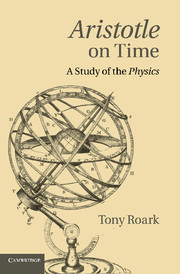Book contents
- Frontmatter
- Contents
- Preface
- List of figures
- List of abbreviations
- Introduction
- PART I TIMES NEW AND OLD
- PART II THE MATTER OF TIME: MOTION
- 3 Time is not motion
- 4 Aristotelian motion
- 5 “The before and after in motion”
- PART III THE FORM OF TIME: PERCEPTION
- PART IV SIMULTANEITY AND TEMPORAL PASSAGE
- References
- Index locorum
- General index
5 - “The before and after in motion”
Published online by Cambridge University Press: 03 May 2011
- Frontmatter
- Contents
- Preface
- List of figures
- List of abbreviations
- Introduction
- PART I TIMES NEW AND OLD
- PART II THE MATTER OF TIME: MOTION
- 3 Time is not motion
- 4 Aristotelian motion
- 5 “The before and after in motion”
- PART III THE FORM OF TIME: PERCEPTION
- PART IV SIMULTANEITY AND TEMPORAL PASSAGE
- References
- Index locorum
- General index
Summary
Aristotle's non-temporal conception of motion saves his definition of time as “a number of motion with respect to the before and after” from circularity, at least insofar as “motion” appears in the definiens. But the definition will nonetheless fail unless “before” and “after” can also be explicated independently of temporal notions. And they can be.
It goes without saying that “before” and “after” do indeed denote familiar, reciprocal temporal relations: Armstrong's moon landing is (in some timeless sense of “is”) before Nixon's death – and the latter is after the former – because the landing occurred at a date earlier than the death. But as this illustration makes amply clear, every relation requires relata, and so I shall speak of the before and after in motion, as well as in time, in terms of the entities that function as the relata for each respective relation, whatever those relata might turn out to be. On the hylomorphic interpretation of Aristotle's theory of time, the temporal entities denoted by “before” and “after” as used in their temporal sense must have some variety of kinetic entities as their matter. Moreover, the existence of such kinetic entities provides a proper referent for “before” and “after” used in a distinctly kinetic sense. My contention is that Aristotle uses the terms in precisely this sense in his definition of time, and that the definition is therefore not circular in any respect.
Information
- Type
- Chapter
- Information
- Aristotle on TimeA Study of the Physics, pp. 80 - 102Publisher: Cambridge University PressPrint publication year: 2011
